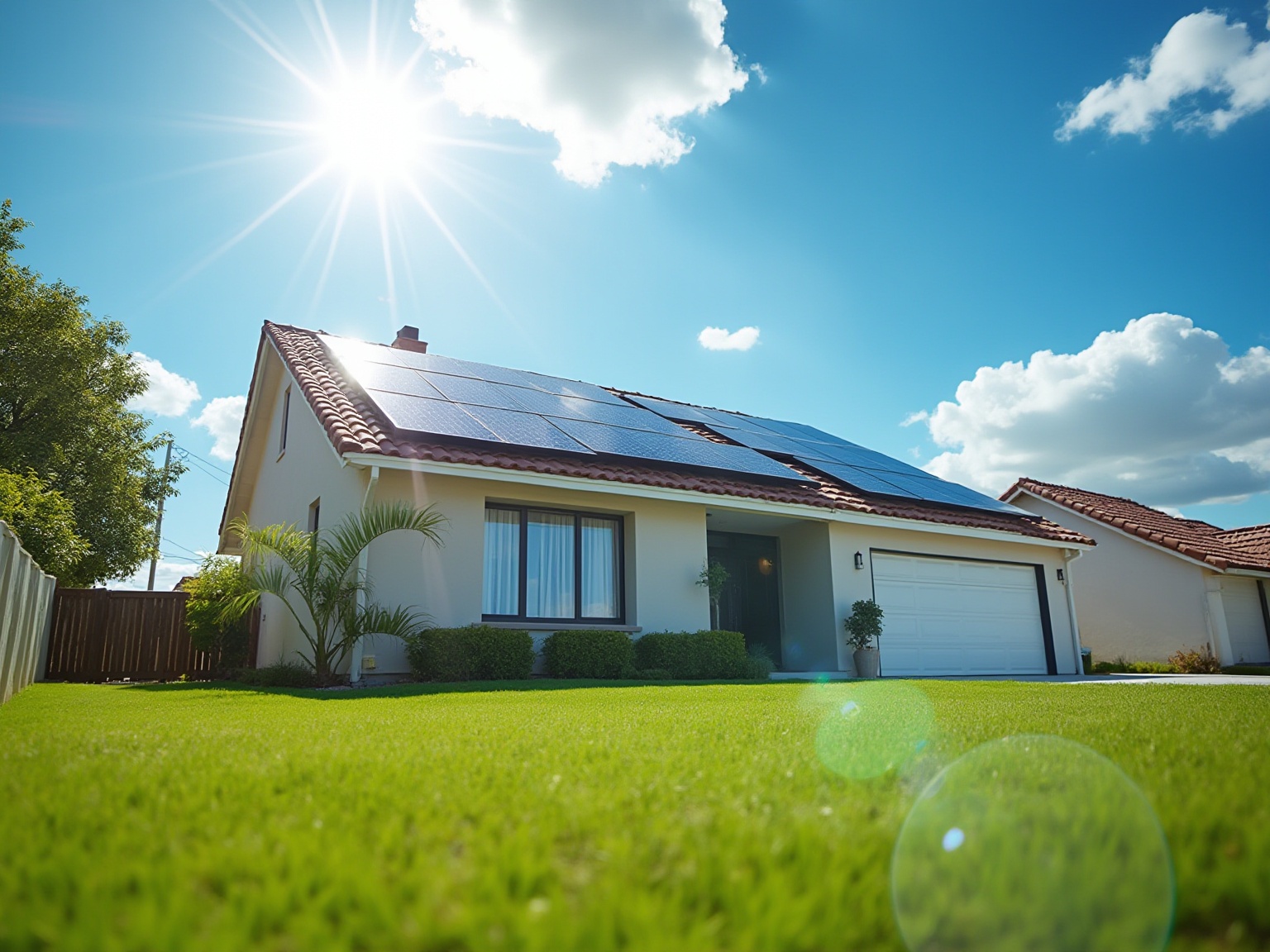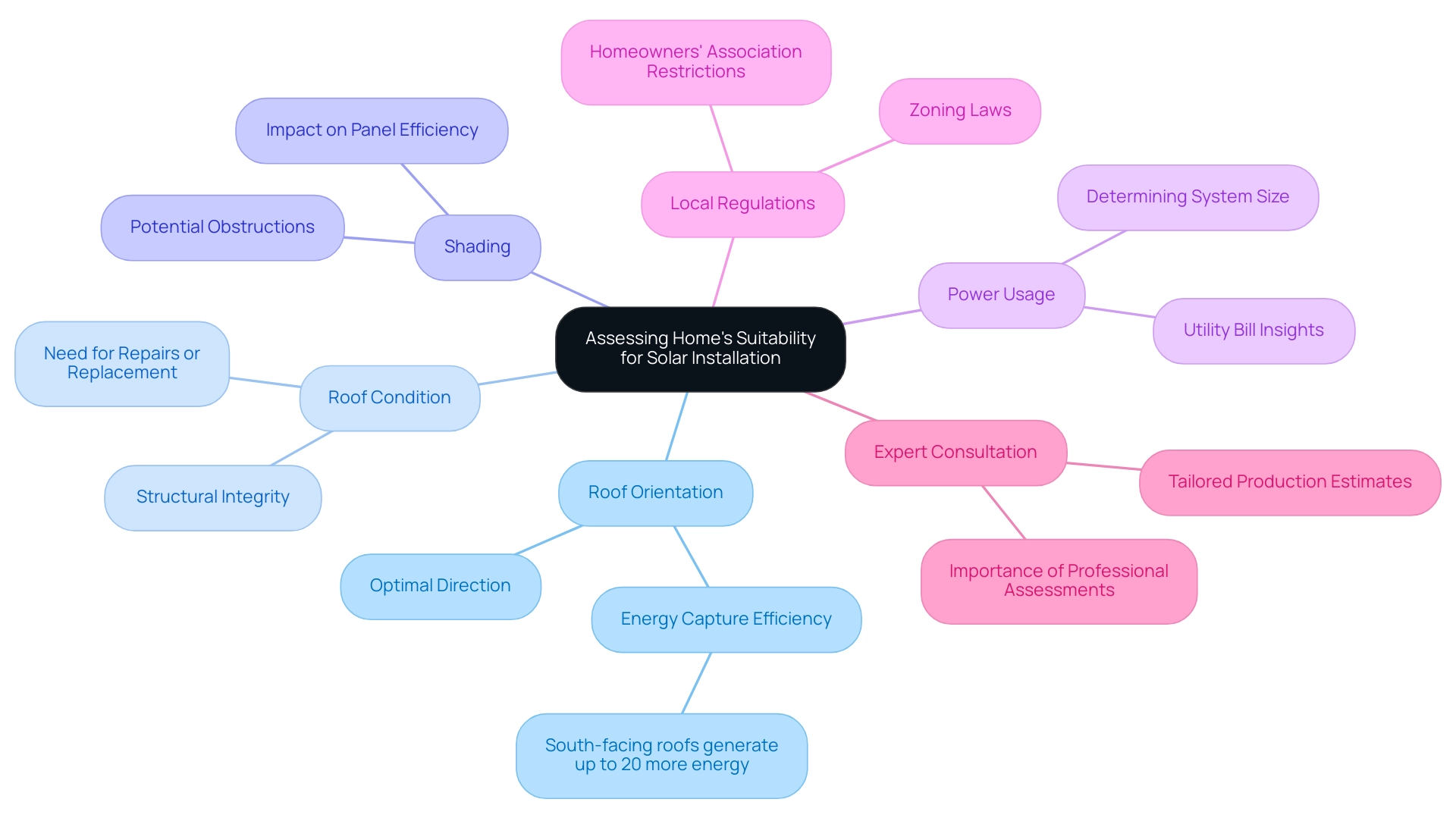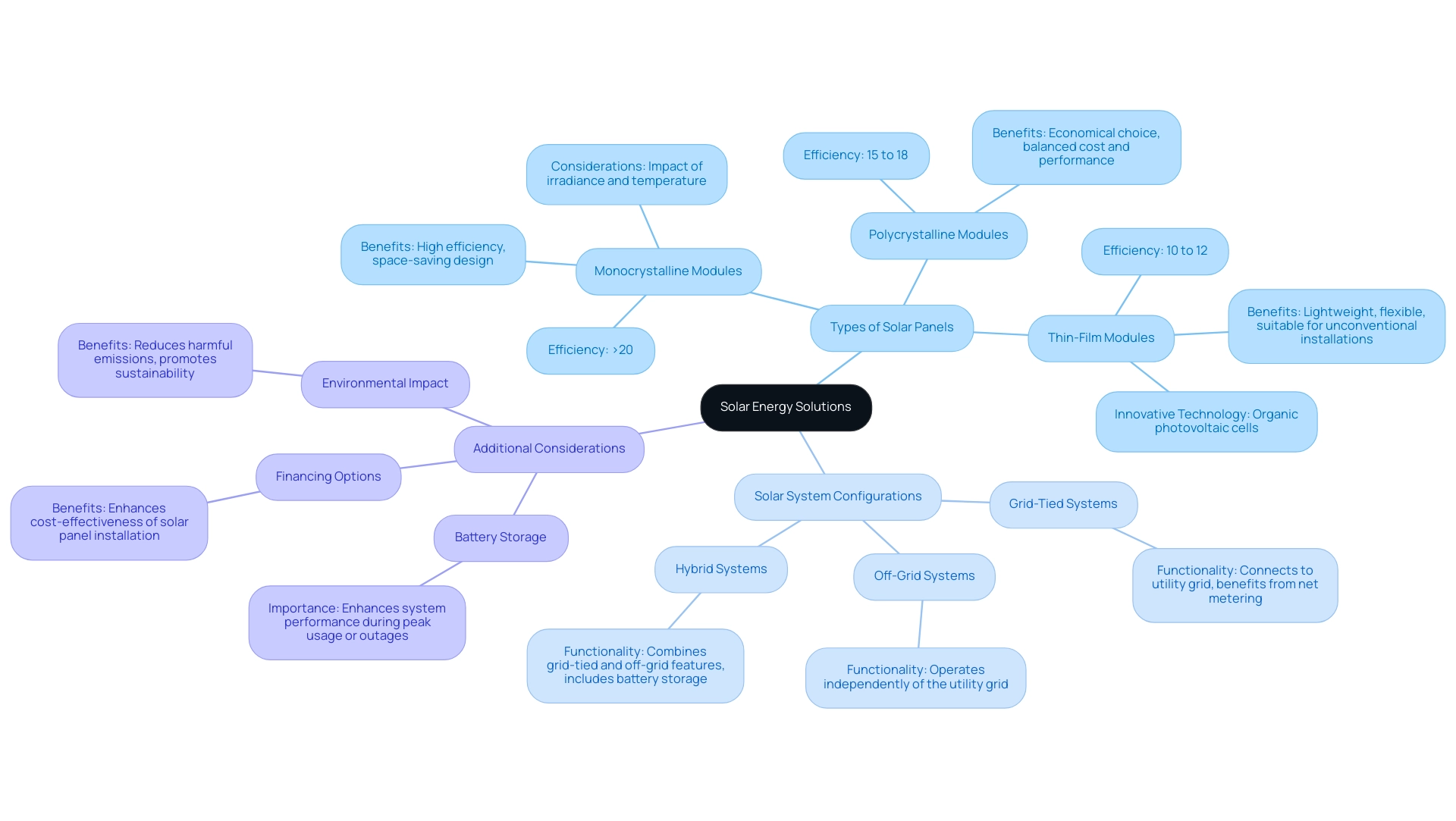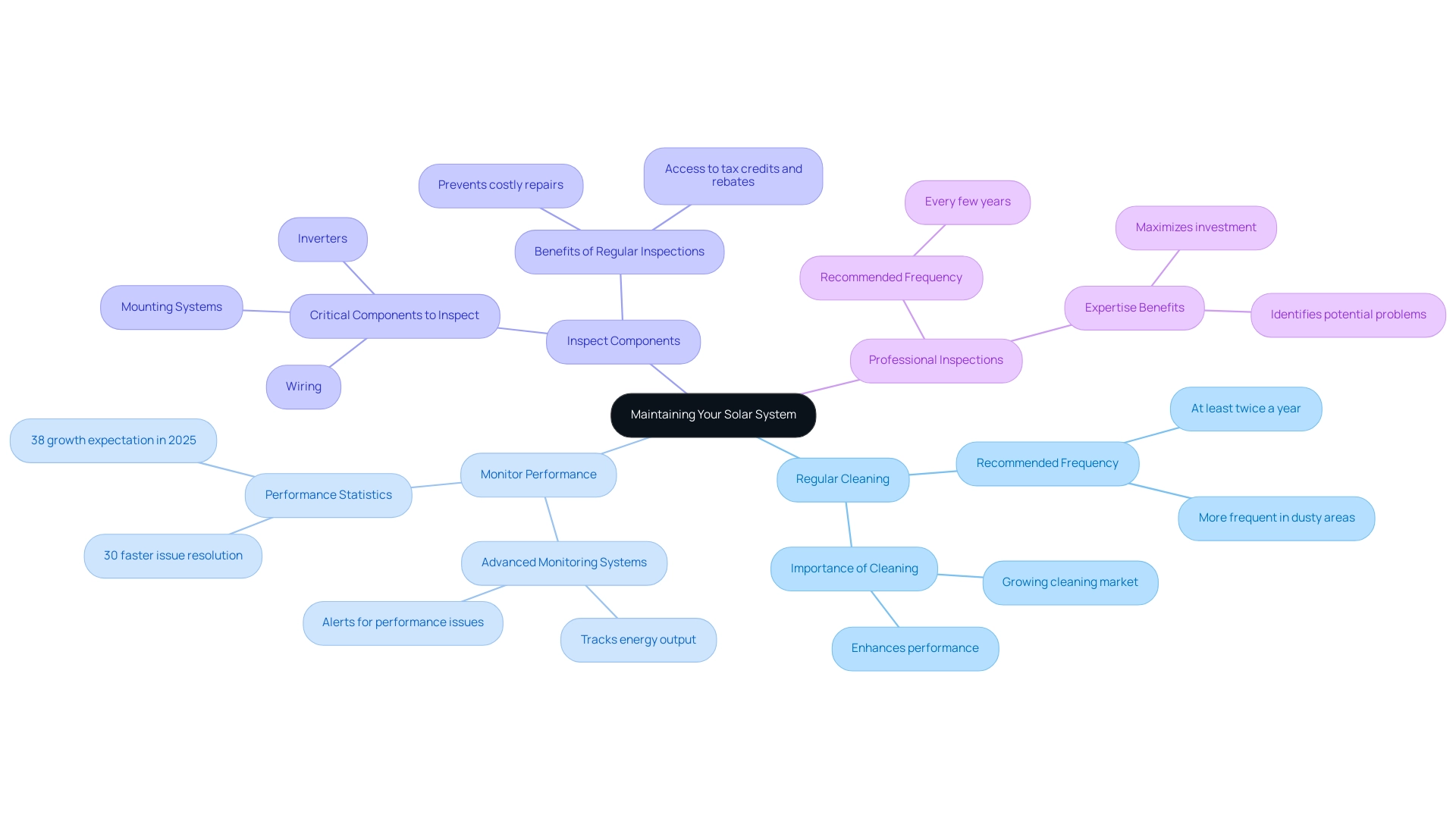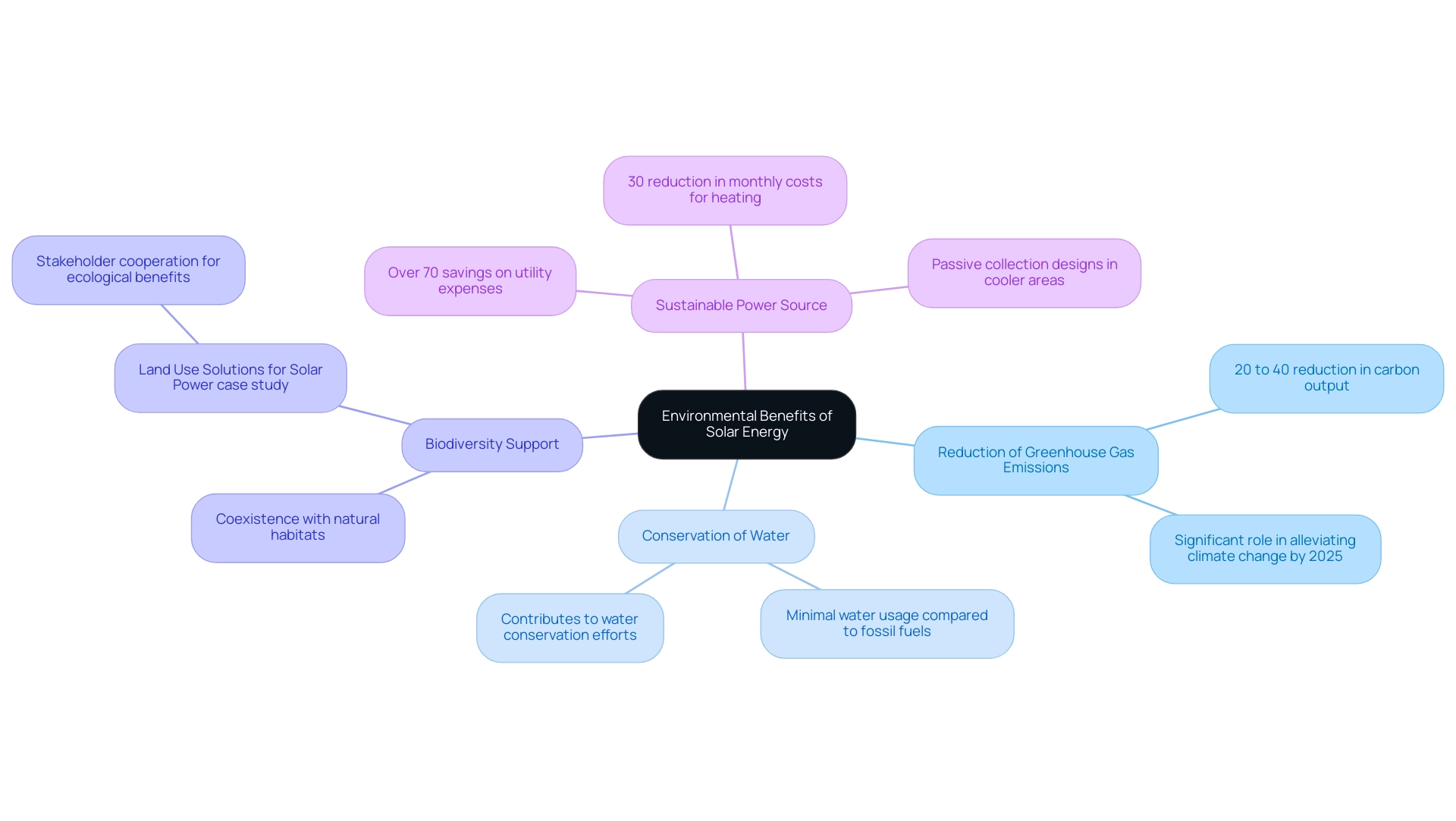Overview
This article is here to guide you through the process of choosing and installing solar panels for your home, recognizing the weight of concerns about rising energy bills. We understand that making the switch to solar energy can feel daunting, but it’s a step towards energy independence that brings numerous benefits. By assessing your home’s suitability, understanding the different types of solar panels available, and navigating the installation process, you can feel empowered in your decision.
We encourage you to evaluate crucial factors such as roof orientation and condition, as well as the financial implications of installation. It’s common to feel overwhelmed by these decisions, but rest assured, we provide detailed guidance and best practices for maintenance that can help you along the way. Together, we can ensure you have the necessary knowledge to make informed decisions about adopting solar energy solutions.
By embracing solar energy, you’re not just investing in your home; you’re also contributing to a sustainable future. Let’s work towards a brighter tomorrow, where your energy needs are met with clean, renewable sources. If you have any questions or need support, don’t hesitate to reach out—we’re here to help you every step of the way.
Introduction
As we navigate the shift towards sustainable energy solutions, many homeowners find themselves concerned about rising energy bills and the impact on our planet. It’s common to feel overwhelmed by these challenges, but solar energy stands out as a beacon of hope, offering a wealth of benefits not just for your home, but also for the environment. By harnessing sunlight through innovative technologies like photovoltaic panels, you can enjoy significant cost savings on electricity bills while taking a meaningful step towards reducing your carbon footprint and promoting energy independence.
With the solar industry poised for growth, it becomes essential to explore the advantages and practical considerations of adopting solar energy. Together, we can understand how this choice not only benefits your financial future but also contributes positively to the health of our planet. This comprehensive guide delves into the fundamentals of solar energy, exploring its financial implications, installation processes, and the long-term environmental benefits that make it a compelling choice for conscientious homeowners. Let’s work towards a brighter, more sustainable future together.
Understanding Solar Energy: Basics and Benefits
Solar power is captured from sunlight through photovoltaic (PV) devices, transforming sunlight into electricity. We understand that concerns about rising energy bills can be daunting, but the advantages of adopting solar energy are substantial and multifaceted:
- Cost Savings: Homeowners can significantly reduce their electricity bills over time. In fact, the average U.S. homeowner can save approximately $50,000 over 25 years after installing photovoltaic panels, although actual savings may vary based on state and local electricity costs. This long-term financial advantage is further enhanced by incentives such as statewide tax credits and power storage rebates, making installations more accessible and affordable. Furthermore, water heating systems can further boost savings by decreasing dependence on conventional power sources for heating water, contributing to overall utility cost reductions. These systems can heat water to temperatures as high as 400 degrees Fahrenheit, making them efficient and effective.
- Environmental Impact: Using sunlight power contributes to a lower carbon footprint by reducing dependence on fossil fuels. Solar water heaters, for instance, can heat water to high temperatures using sunlight, significantly reducing greenhouse gas emissions. As the demand for clean power solutions grows, the solar industry is projected to see a 46% increase in deployment due to supportive legislation, underscoring the shift towards sustainable practices.
- Self-Sufficiency in Power: Solar modules offer residents a dependable power source, especially advantageous during blackouts. By producing their own power, homeowners can secure their costs at a consistent rate, alleviating concerns about annual rate increases from utility companies. As Emily Walker states, “When you generate your own energy with a panel system, you lock in your energy costs at a consistent rate, which means you no longer have to worry about annual rate increases from your utility.”
- Increased Property Value: Homes equipped with energy installations often experience an increase in market value. This enhancement not only reflects the growing demand for energy-efficient homes but also positions properties favorably in a competitive real estate market. Furthermore, the long-term value of renewable water heaters can appeal to eco-conscious buyers, making homes with these systems even more attractive.
While the prospects for renewable resources are promising, it’s common to feel uncertainty due to political actions, such as President Trump’s executive order pausing funds from the Inflation Reduction Act. Grasping these advantages and difficulties is essential for property owners contemplating renewable power options. By switching to renewable energy, including solar panels to power their homes, they not only invest in their financial future but also contribute positively to the environment and enhance their home’s value.
Together, we can embrace innovative sunlight solutions that enable homeowners to utilize the advantages of renewable power. Powercore Electric is dedicated to supporting you on this journey.
Assessing Your Home’s Suitability for Solar Installation
Assessing whether your home is suitable for solar energy systems involves considering several important factors that can significantly impact your energy needs and costs.
- Roof Orientation: We understand that the direction of your roof plays a vital role in energy capture. Ideally, roofs facing south capture the most sunlight, but east and west orientations can also be effective. Studies show that homes with south-facing roofs can generate up to 20% more energy than those with less optimal orientations, making this a crucial factor in your assessment.
- Roof Condition: It’s essential to inspect your roof thoroughly. It should be structurally sound and able to support the weight of photovoltaic modules. If your roof needs repairs or replacement, addressing these issues before installation is advisable to ensure a smooth transition.
- Shading: Take a moment to assess your property for any potential shading from trees, buildings, or other obstructions that could limit sunlight exposure. Even partial shading can significantly reduce panel efficiency, so identifying and mitigating these factors is key to maximizing your solar investment.
- Power Usage: Reflect on your utility bills to gain insights into your consumption patterns. Understanding your power consumption will help you determine the scale of the photovoltaic system needed to meet your energy needs efficiently.
- Local Regulations: Familiarizing yourself with local zoning laws and any homeowners’ association (HOA) restrictions is crucial. These regulations can impact your ability to install photovoltaic panels, and adhering to them will help prevent potential legal issues.
By thoroughly evaluating these factors, you can gain a clearer understanding of the practicality of renewable energy for your residence. For example, a recent case study highlighted the importance of consulting with installers to accurately assess a roof’s energy generation potential. Expert assessments can tailor production forecasts based on unique roof characteristics, ensuring that property owners make informed decisions about their energy setups.
Furthermore, understanding the advantages of government panel programs can enhance your decision-making process. These initiatives often provide financial incentives and assistance for homeowners transitioning to renewable sources. As Anna Brui, a writer passionate about renewable resources and sustainability, emphasizes, grasping these factors is essential for effectively transitioning to photovoltaic solutions. By taking these steps, you can confidently move forward in utilizing solar panels to power your home sustainably.
Moreover, Powercore Electric’s dedicated team of specialists ensures top-notch installations and maintenance, reinforcing their commitment to helping residents achieve optimal renewable solutions. Together, we can make a meaningful impact on our energy future.
Exploring Different Types of Solar Panels and Systems
When considering solar energy solutions for your home, we understand that the rising energy bills can be a significant concern. It’s essential to explore the three primary types of solar panels available in 2025, each offering unique benefits tailored to your needs:
- Monocrystalline Modules: These panels are celebrated for their high efficiency and space-saving design, making them a preferred choice for homeowners with limited roof space. With efficiencies exceeding 20%, they present a powerful option, even though they come at a higher cost. A recent study on the performance of monocrystalline photovoltaic solar cells revealed that factors like irradiance and temperature can significantly impact efficiency. This underscores the importance of selecting the right type of module for your specific environment.
- Polycrystalline Modules: If budget is a concern, these modules offer a more economical choice with slightly lower efficiency, generally ranging between 15% to 18%. They are a solid option for property owners seeking to balance cost and performance, ensuring that you don’t have to compromise on quality.
- Thin-Film Modules: Lightweight and flexible, thin-film modules are perfect for unconventional installations. While their efficiencies are generally lower, around 10% to 12%, their adaptability makes them suitable for various applications, including building-integrated photovoltaics. As Melody Abeni insightfully notes, “Organic photovoltaic cells produce electricity similarly to conventional systems, but they utilize organic semiconductors rather than silicon,” highlighting an innovative technology that may resonate with environmentally conscious residents.
In addition to the types of panels, it’s crucial to consider the configuration of your solar system:
- Grid-Tied Systems: These systems connect directly to the utility grid, allowing you to benefit from net metering, which can significantly reduce your electricity costs.
- Off-Grid Systems: Ideal for isolated areas, off-grid systems function independently of the utility grid, offering complete power autonomy, which can be liberating.
- Hybrid Systems: By combining the features of both grid-tied and off-grid systems, hybrid setups often include battery storage, providing flexibility and reliability during power outages.
Furthermore, when examining renewable power solutions, investigating the top battery choices for effective storage is essential. Batteries can enhance your power system’s performance, ensuring that you have access to stored resources during peak usage times or outages. As photovoltaic costs have dropped by 70% over the past decade, investing in solar panels not only cuts harmful emissions but also leads to significant savings on your monthly utility bills.
Additionally, exploring funding alternatives for photovoltaic system installation can further enhance the cost-effectiveness of switching to renewable energy. Together, by evaluating these factors, you can make an informed decision that aligns with your sustainability goals and financial considerations. Let’s work towards a brighter, more sustainable future together.
Financial Considerations: Costs, Incentives, and Savings
When you think about installing photovoltaic systems, it’s natural to have concerns about the financial implications. We understand that energy bills can weigh heavily on your budget, and exploring sustainable options is a significant step towards energy independence.
- Installation Costs: In 2025, the average costs for panel installation in California range from $13,549 to $25,974 for a typical residential property. This investment can vary based on system size, equipment quality, and installation complexity. Thankfully, the federal renewable energy investment tax credit allows you to deduct 30% of the installation costs from your federal taxes, making these installations more affordable and accessible.
- Incentives: Homeowners can take advantage of this federal renewable energy investment tax credit, which offers a deduction of 30% of the installation costs from their federal taxes. This important motivation is essential for making photovoltaic installations more economical and reachable.
- Long-Term Savings: By switching to renewable power sources, you can look forward to saving around $48,000 over 25 years by significantly lowering or even eliminating your electricity expenses. Moreover, the overall worth of avoided utility expenses during this timeframe can reach an impressive $108,915, highlighting the financial advantages of renewable sources. This cost analysis clearly demonstrates the potential savings when choosing solar panels to power your home instead of relying on conventional electricity sources.
- Intermittence and Power Storage: It’s common to feel uncertain about the reliability of sunlight-derived power, as it can be intermittent. Therefore, it’s important to evaluate power storage options, such as Tesla home chargers and premium battery systems, to efficiently manage supply and demand, ensuring you have a dependable power source. Understanding the characteristics and market trends of these storage alternatives can further enhance your efficiency and sustainability.
- Financing Options: Various financing solutions are available, including loans, leases, and power purchase agreements (PPAs). Exploring these alternatives can help you find a payment structure that aligns with your financial situation and goals, making the transition to renewable power sources smoother.
Grasping these financial elements is vital for making an informed investment in sustainable technology. Together, we can create opportunities for sustainable practices and increased energy autonomy. If you have any questions or need guidance, don’t hesitate to reach out—we’re here to support you on this journey.
The Installation Process: Steps to Get Your Solar Panels Up and Running
The installation of solar panels to power your home involves a systematic process designed to ensure efficiency and compliance with regulations. We understand that navigating this journey can feel overwhelming, but we’re here to guide you every step of the way. Here are the key steps typically involved:
- Site Assessment: A qualified expert performs a comprehensive analysis of your property to determine the best renewable solution customized to your power requirements. This assessment examines elements such as roof orientation, shading, and structural integrity. It’s important for homeowners to comprehend their specific power needs when considering the installation of solar panels.
- Design and Permitting: After the site assessment, the energy company designs a customized system that incorporates solar panels to power your house and maximizes energy production. This phase also includes obtaining the necessary permits, which can be a significant hurdle; approximately 33% of companies in the renewable energy sector cite permitting as a major barrier to installation. Understanding these challenges highlights the importance of choosing a knowledgeable provider like Powercore Electric, who can navigate these complexities effectively.
- Skilled technicians perform the installation of solar panels, inverters, and other essential components. This step is crucial, as the quality of installation directly impacts system performance and longevity. Homeowners should also consider the best practices for choosing inverter systems to enhance their power storage solutions.
- Inspection: After installation, local authorities conduct an inspection to ensure that the system meets all regulatory standards. This step is vital for ensuring safety and compliance with local codes, reinforcing the importance of regular maintenance for efficiency and longevity.
- Connection to the Grid: Once the installation passes inspection, the system is connected to the utility grid. This connection enables property owners to take advantage of net metering, which can greatly lower utility expenses by crediting surplus power generated. Understanding the advantages of government energy panel programs can further enhance these savings.
Ultimately, once all authorizations are obtained, the system is initiated, allowing homeowners to begin producing clean power. Collaborating with a community-oriented firm such as Powercore Electric guarantees that you receive tailored service and professional advice during this process, improving your shift to renewable resources.
In 2025, 78% of photovoltaic installers expect a rise in sales, indicating a growing trend towards alternative power adoption. This is further supported by the fact that 38% of companies in the renewable energy sector expect growth, indicating a robust market for energy solutions, as noted by policy analyst Ben Zientara. Moreover, the most favored incentives for installers consist of statewide tax credits and storage rebates, offering financial advantages to property owners contemplating installation.
Powercore Electric sets itself apart with its strong community emphasis and dedication to transparency, guaranteeing high-quality installations and maintenance, while also informing residents about the significance of comprehending residential energy system sizes and the advantages under the 200% rule. To demonstrate the advantages of residential photovoltaic systems under the 200% rule, case studies reveal that residents have considerably lowered their utility expenses and enhanced their property value after installation. Moreover, the thorough manual on how photovoltaic systems operate offers crucial understanding into the functionality of these systems, assisting homeowners in making knowledgeable choices regarding their power requirements.
Maintaining Your Solar System: Best Practices for Longevity
To ensure your energy system operates at peak efficiency and longevity, it’s essential to embrace some best practices that can truly make a difference in your experience as a homeowner:
-
Regular Cleaning: We understand that keeping your energy collectors clean can feel like a chore, but it’s recommended to clean them at least twice a year. This simple act helps remove dust, debris, and other obstructions that can hinder performance. If you live in an area with significant pollen or dust, you might find that more frequent cleaning is necessary to sustain optimal power generation. The increasing need for efficient cleaning services in the photovoltaic cleaning market highlights just how important this practice is. Luckily, cutting-edge cleaning technologies are now accessible, providing effective solutions that can enhance the cleaning process and ensure your modules stay in optimal condition.
-
Monitor Performance: It’s common to feel uncertain about how well your energy production is performing. Utilizing advanced monitoring systems can help alleviate that concern by tracking your energy output. These systems can alert you to any performance issues, allowing for timely interventions. Statistics indicate that homeowners who actively monitor their systems can identify and resolve issues 30% faster than those who do not. This is particularly relevant as 38% of companies in the photovoltaic sector expect to grow in 2025, emphasizing the industry’s focus on performance optimization and the importance of maintaining your panels for maximum efficiency.
-
Inspect Components: Regularly inspecting critical components such as wiring, inverters, and mounting systems for signs of wear and tear is a proactive approach that can prevent minor issues from escalating into costly repairs. Powercore Electric’s in-house team of experts ensures high-quality installations and maintenance, reinforcing the value of professional services in this regard. By keeping your system well-maintained, you can also take advantage of government programs that offer tax credits and rebates for efficiency improvements.
-
Professional Inspections: We encourage you to schedule professional inspections every few years. Experts recommend this practice to ensure that all system components are functioning correctly and to identify potential problems before they affect performance. By leveraging the expertise of professionals, property owners can maximize their investment in sustainable resources and benefit from statewide tax credits and energy storage rebates, which are popular incentives that can offset maintenance costs.
By implementing these best practices, together we can significantly extend the lifespan of your photovoltaic system and maximize your investment in sustainable resources. The rising number of photovoltaic installations and favorable government incentives further highlight the importance of maintaining your energy system effectively.
The Environmental Benefits of Solar Energy: A Sustainable Choice
Solar energy offers a multitude of environmental advantages that make it an appealing choice for homeowners who are concerned about rising energy costs and their impact on the planet:
- Reduction of Greenhouse Gas Emissions: We understand that many homeowners worry about their carbon footprint. Solar power generates electricity without releasing harmful pollutants, significantly contributing to the reduction of greenhouse gas emissions. In 2025, renewable power is anticipated to play a vital role in alleviating climate change, with studies suggesting that widespread adoption could lead to a significant reduction in emissions across various sectors. As Inemesit Ukpanah, an experienced content creator, emphasizes, the shift to renewable sources is crucial for a sustainable future. Notably, sunlight-powered air heaters can decrease a household’s carbon output by 20 to 40 percent, making them an essential component of this transition.
- Conservation of Water: It’s common to feel concerned about water scarcity, especially in places like California. Unlike conventional fossil fuel power generation, which can consume substantial quantities of water for cooling and processing, photovoltaic systems require minimal water. By harnessing sunlight, homeowners can install solar panels to power their homes while conserving this vital resource and producing clean energy. Statistics indicate that sunlight-based power generation significantly reduces water usage compared to traditional power sources, allowing you to contribute to water conservation.
- Biodiversity Support: We all care about the environment and the creatures that inhabit it. Solar installations can be designed to coexist harmoniously with natural habitats, promoting biodiversity. Innovative land use solutions are being developed to ensure that energy projects deliver economic, social, and ecological benefits to local communities. For example, the case study titled ‘Land Use Solutions for Solar Power’ highlights how cooperation among stakeholders can improve the implementation of renewable resources while addressing land use disputes, ultimately benefiting local ecosystems.
- Sustainable Power Source: As a renewable and abundant resource, sunlight contributes to a sustainable future. The transition to renewable power not only helps decrease dependence on fossil fuels but also supports the development of a robust power infrastructure. Significantly, case studies from Southern California illustrate that households can achieve over 70% savings on utility expenses by using solar panels to power their heating systems. Additionally, homes in cooler areas have effectively utilized passive collection designs to significantly lower their costs. Furthermore, using solar panels to power house air heaters can reduce monthly costs by 30 percent, making them particularly suitable for residential applications where power consumption is high.
By choosing renewable power through Powercore Electric, you can significantly reduce your carbon footprint, conserve water, and support a healthier planet. The environmental benefits of solar energy adoption are clear, making it a wise choice for those looking to make a positive impact. Together, we can create a sustainable future for ourselves and generations to come.
Conclusion
Transitioning to solar energy presents a transformative opportunity for homeowners, addressing your concerns about rising energy bills while combining financial benefits, environmental responsibility, and energy independence. By harnessing sunlight through photovoltaic panels, you can significantly reduce your electricity bills, with the potential for savings of around $50,000 over 25 years. This financial advantage is further supported by various incentives, such as the federal solar investment tax credit, which enhances the affordability of solar installations.
We understand that the environmental impacts of adopting solar energy are equally compelling. Solar power generates clean electricity, drastically reducing greenhouse gas emissions and reliance on fossil fuels. Additionally, solar energy systems require minimal water compared to traditional energy sources, contributing to vital water conservation efforts. This shift not only supports a sustainable future but also promotes biodiversity by allowing solar installations to coexist with natural habitats.
Moreover, by generating your own electricity, you gain energy independence, shielding yourself from the volatility of utility rates and potential outages. This autonomy, combined with the increased property value that solar installations can bring, makes solar energy an attractive investment for conscientious homeowners like you.
In conclusion, embracing solar energy through a comprehensive understanding of its benefits, installation processes, and maintenance best practices paves the way for a sustainable and financially sound future. By choosing solar, you not only invest in your own financial well-being but also play a crucial role in fostering a healthier planet for generations to come. Together, we can make a difference—the time to act is now. Solar energy is more than just a trend; it is a vital step toward a brighter, sustainable tomorrow.


